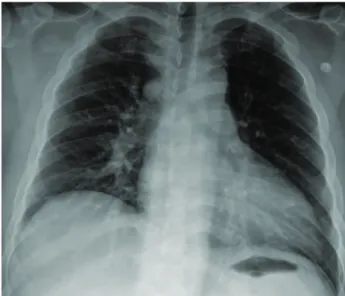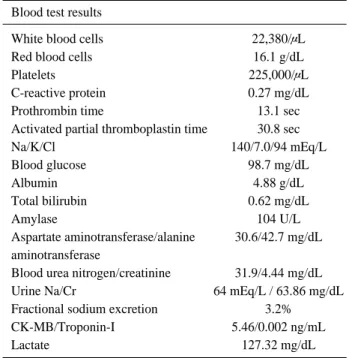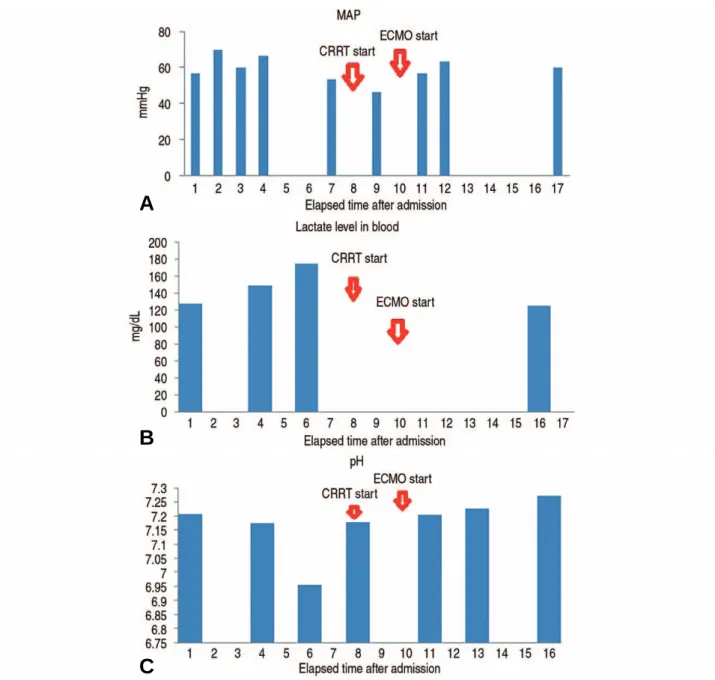증 증 례례
INTRODUCTION
Calcium channel blockers (CCBs) block transmem- brane flow of calcium ions through voltage-gated chan- nels and are effective treatment for hypertension, angi- na, and arrhythmia
1). Angiotensin II receptor blockers (ARBs) inhibit activity of angiotensin II on smooth mus- cles of blood vessels, thereby reducing blood pressure
2). Overdosing of CCBs and ARBs, and/or concomitant administration of other antihypertensive agents can result in hypotension
1-3). Metformin is an antihyper-
에크모와 신대체요법을 이용하여 치료한 칼슘채널차단제, 안지오텐신 수용체 차단제, 메트포민 중독 환자 증례
조선대학교 의과대학 흉부심혈관외과학교실1, 조선대학교 의과대학 응급의학교실2
정재한
1∙선경훈
2∙박용진
2∙김선표
2Extracorporeal Membrane Oxygenation and Continuous Renal Replacement Therapy for Treatment of Calcium Channel Blockers,
Angiotensin II Receptor Blockers, and Metformin Overdose
Jae Han Jeong, M.D.
1, Kyung Hoon Sun, M.D., Ph.D.
2, Yong Jin Park, M.D., Ph.D.
2, Sun Pyo Kim, M.D., Ph.D.
2Department of Thoracic and Cardiovascular Surgery, Chosun University College of Medicine, Gwangju
1, Department of Emergency Medicine, Chosun University College of Medicine, Gwangju
2, Korea
An overdose of antihypertensive agents, such calcium channel blockers (CCBs) and angiotensin II receptor blocker (ARBs), and the antihyperglycemic agent, metformin, leads to hypotension and lactic acidosis, respectively.
A 40-year-old hypertensive and diabetic man with hyperlipidemia and a weight of 110 kg presented to the emer- gency room with vomiting, dizziness, and hypotension following an attempted drug overdose suicide with combined CCBs, ARBs, 3-hydroxy-3-methylglutaryl-coemzyme A reductase inhibitors, and metformins. A conventional med- ical treatment initially administered proved ineffective. The treatment was then changed to simultaneous extracorpo- real membrane oxygenation (ECMO) and continuous renal replacement therapy (CRRT), which was effective. This shows that simultaneous ECMO and CRRT can be an effective treatment protocol in cases of ineffective conven- tional medical therapy for hypotension and lactic acidosis due to an overdose of antihypertensive agents and met- formin, respectively.
Key Words: Calcium channel blockers, Angiotensin receptor antagonist, Metformin, Extracorporeal membrane oxy- genation, Renal replacement therapy
책임저자: 선 경 훈
광주광역시 동구 필문대로 365 조선대학교 의과대학 응급의학교실 Tel: 062) 220-3285 Fax: 062) 224-3501 E-mail: skhkorea@hanmail.net
투고일: 2018년 9월 17일 1차 심사일: 2018년 9월 18일 게재 승인일: 2018년 10월 22일
* This study was supported by research funds from Chosun University Hospital 2017.


